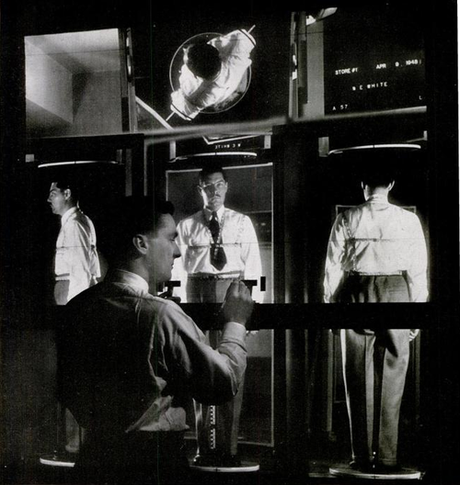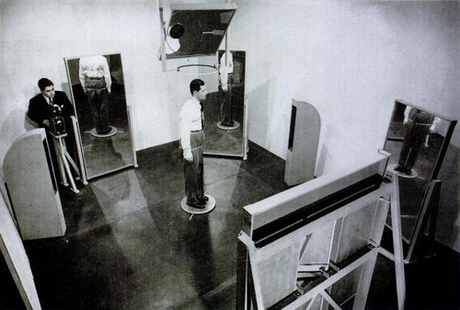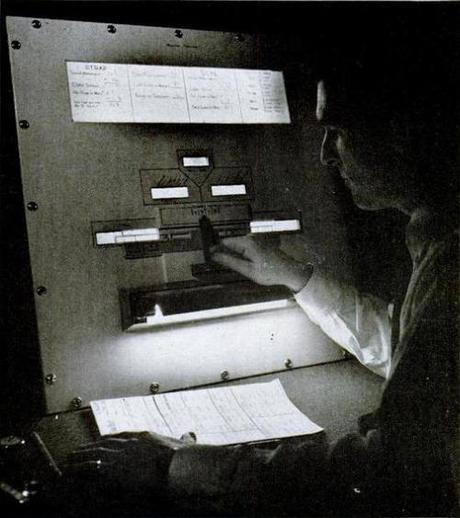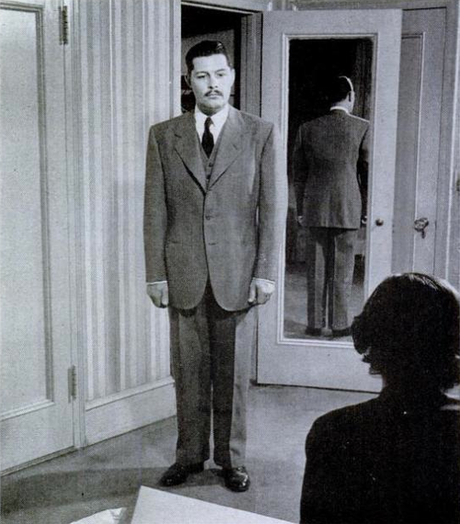
Will Boehlke at A Suitable Wardrobe raised an interesting question this past Tuesday on how far technology can be taken in the world of bespoke tailoring. After all, there are now “body scanning pods,” where a man strips down to his underwear, steps into the machine, and stands according to the florescent markers on the floor. Light is then projected over his body and hundreds of measurements are taken, enough so that a full three-dimensional scan is produced. Ostensibly this is much better than the couple of dozen measurements a tailor can produce, and whatever asymmetry, curvature, and slope that he could guesstimate with his eye.
This all reminded me of an amusing article from a June 1948 issue of Life Magazine, which touts some new fangled system at the time called Photo-Metric. This new measuring technology involved a client standing on a pedestal and wearing a special harness made of tape measurers. Around him would be four mirrors, specially placed so that they would reflect the image of his body. A photo was then taken and sent to a “lab,” where various gauges and geometric calculators furnished the “tailor” not only with the exact figures of the client’s usual measurements (chest size, arm length, and what not), but also the slope of his shoulders and spatial relation of waist to chest. It was presumed that from this, a much better fitting suit could be made, but we all know the final verdict on that. My tailors still just use a $2 tape measurer, no different than what you’d find at a common supermarket.
But at some point we can assume technology will improve and genuinely good scans can be made. From that, perhaps better patterns can be drafted. Which raises Will’s interesting question: is it bespoke?
I recently had the opportunity to talk to Thomas Mahon about pattern drafting, and am turning the material into an article for The Rake. It would be too much to summarize our conversation here, but one interesting thing that arose was Thomas’ comment that pattern drafting isn’t at the heart of bespoke tailoring. “It’s all about the fitting,” he said. In fact, the real difference between made-to-measure and bespoke isn’t that the first drafts a pattern from computer and the other by hand, but that the first only involves only one fitting and the second multiple. It’s the constant refining and adjustment of the garment that makes bespoke special.

If scanning technologies advanced far enough, I suppose fittings could be done away with all together, so this difference might be moot. Assuming you could still specify whatever details you’d like in a garment, and the construction was still hand-done, then yes, I suppose it would be bespoke. The only difference is that a somewhat more human experience of feeling the tailor’s tape measure gently wrapped around your neck would be replaced by a sterile experience of being nearly naked in a pod (well, one would hope it’s a sterile experience).
Presumably, this could have an impact on what’s known as the “traveling tailors model,” where tailors from abroad visit clients in hotel rooms in order to measure and fit them for bespoke garments. If one could have a full body scan done anywhere, why couldn’t you just send those to whatever Savile Row, Neapolitan, or Hong Kong maker you prefer? Communication could take place over Skype and fabrics could be furnished by whatever mill you’ve chosen. A month or two later, your garment arrives in a box. What strange day that would be, but I suppose even then, we’d have to admit: it’s still bespoke.



